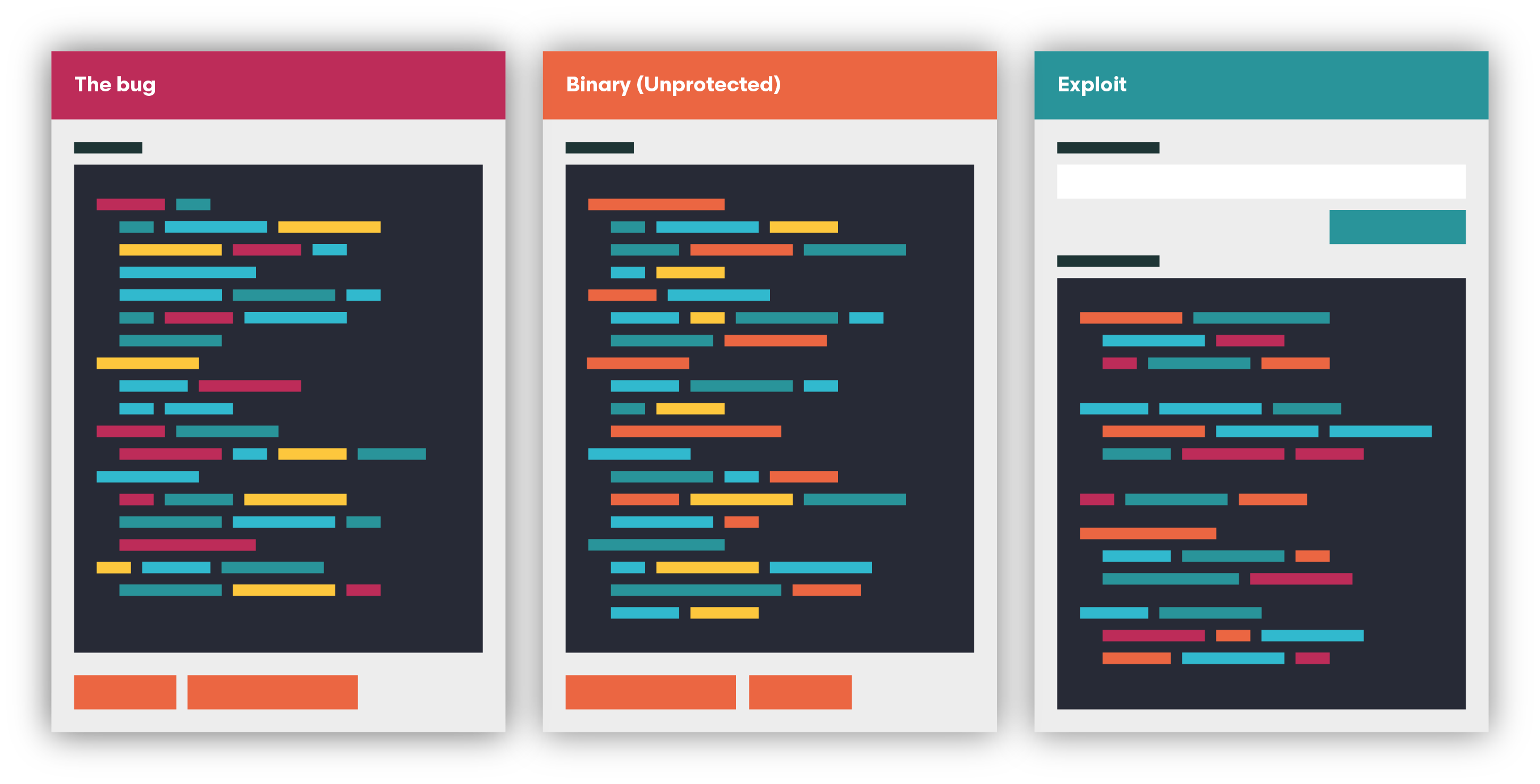
Defend against the threat of Reverse Engineering with Emproof Nyx
Reverse engineering unveils hidden code and vulnerabilities, turning secrets into potential threats.
The threat of reverse engineering
Reverse engineering poses a significant threat to companies by exposing proprietary software to intellectual property (IP) theft and security breaches. Moreover, when attackers reverse engineer software, they can uncover and extract hardcoded keys and exploit vulnerabilities, which may lead to unauthorized access and misuse of sensitive data. Such breaches not only result in financial losses due to IP theft but also damage a company’s reputation and competitive advantage. It is crucial to understand these methods to protect against potential exploitation.
Find out how these threats are exploited
70%
of severe security vulnerabilities in major tech companies are caused by memory safety issues.
~80%
of embedded systems will continue to rely on memory-insecure languages, such as C/C++, in the next decade.
Firmware Extraction
Accessing firmware is often straightforward: Most microcontrollers feature a read-out, which can be used to extract the binary from the device. While modern microcontrollers often provide a read-out protection this can often be circumvented, e.g., by fault attacks or exploiting logic bugs. There are many providers offering firmware read-out as a service. Additionally, firmware updates are often downloadable from provider websites, or URLs can be identified through network sniffing, which attackers can use to retrieve the binary. Moreover, shared libraries or binaries are often directly shipped to customers, enabling direct binary access for further analysis.
- Readout protections can often be bypassed by using fault attacks or exploiting logic bugs.
- Firmware updates can be extracted and downloaded from provider websites; use network sniffing to find URLs.
- This exposes internal code and vulnerabilities, increasing risk of leakage and reverse engineering.
Why is readout protection on the devices not enough?
Readout protection alone is insufficient because it can be bypassed through physical attacks, using logic bugs, and side-channel exploitation. Additionally, it doesn’t address vulnerabilities in the firmware or software itself, nor does it prevent misconfiguration or weaknesses in the implementation. A robust security strategy must include multiple layers of defence, which especially includes advanced software-level protections.
Software Reverse Engineering
Reverse engineering threatens piracy, unauthorized access, and revenue loss. It allows competitors and hackers to clone software, steal valuable algorithms, bypass license checks, unlock premium features, and extract cryptographic data, compromising security and system integrity.
- Reverse engineering is well supported by multiple frameworks and powerful tools like Ghidra, making it accessible even to novices.
- Techniques include disassemblers, control-flow graphs, decompilers, and dynamic analysis.
- Enables software replication, license bypassing, data extraction, and vulnerability identification, causing piracy, revenue loss, and security risks.
How accessible are reverse engineering tools?
There are numerous free resources available online, such as blogs, YouTube tutorials, and Capture the Flag (CTF) challenges, which provide valuable materials for beginners. Tools like Ghidra, a powerful and free reverse engineering software developed by the NSA, offer a good level of code understanding even for those without extensive experience. Additionally, a large community of motivated hobbyists engages in reverse engineering, showcasing that newcomers can successfully learn and apply these techniques.
What are the most popular tools out there to conduct reverse engineering?
The most popular tools for conducting reverse engineering include IDA Pro, Ghidra (open source), BinaryNinja, and Hopper (mostly for MacOS/iOS). Debuggers like WinDBG, x64DBG, GDB, and LLDB are essential for analyzing and debugging code. For firmware analysis, tools like binwalk and the Firmware Analysis Toolkit are popular choices. File format analysis tools such as Detect It Easy, PEiD, and 010editor are also commonly used.
Vulnerability Analysis
Attackers analyse firmware to inject malware, such as ransomware, for extortion. Nation-state actors may use vulnerabilities for espionage or sabotage, targeting critical systems. Competitors might disrupt operations to gain an edge, leading to financial and reputational damage.
- Attackers find and exploit bugs in binaries using reverse engineering.
- They target vulnerable patterns like out-of-bounds writes, non-public API functions, and use-after-free errors.
- They combine pattern matching with in-depth analysis to exploit bugs.
How are these things attacked after the vulnerable points are identified?
Once the attacker has reverse-engineered the firmware or software, they can identify flaws such as buffer overflows, unprotected critical functions, logic bugs, or insecure data handling. This knowledge enables them to craft specific exploits to gain unauthorized access, execute malicious code, or manipulate the device’s behavior. For example, they might exploit a discovered vulnerability to bypass authentication, alter firmware, or extract sensitive data. Reverse engineering essentially provides the attacker with the detailed insights needed to target and exploit specific vulnerabilities within the embedded software.
Cracking
Attackers crack and modify software to unlock paid features, bypass license checks, and adjust hardware limits or geographic restrictions. These actions undermine the software’s intent, create unfair advantages, and pose security risks.
- Patching firmware requires bypassing integrity checks and ensuring device compatibility.
- Exploitation often targets memory corruptions and in-memory patching for dynamic changes.
- These methods risk unauthorised access, revenue loss, and device instability.
How do attackers patch binaries?
A binary can be patched by using tools like Ghidra to directly modify its code or data, or by employing hex editors to manually change specific bytes. Dynamic patching techniques allow for real-time modifications while the binary runs, and if the source code is available, recompiling it with the necessary changes is also an option.
Algorithm Protection
Competitors use reverse engineering to steal technology, create clones, and produce cheaper alternatives.
- Competitors use reverse engineering to copy proprietary algorithms and create cheaper clones.
- It’s used to ensure compatibility, inspect data, and patch device checks.
- These actions can cause financial loss and undermine R&D investments.
What algorithms need protection?
- License validation
- Code dealing with hardcoded keys/credentials
- Valuable algorithm that provide a competive advantage/high R&D costs (protect research secrets)
Key Stealing
Reverse engineering often aims to extract hardcoded keys or API tokens due to compliance issues, lack of secure elements, or poor implementation. Extracting keys or user credentials can lead to unauthorised access, misuse of sensitive data, and IT infrastructure compromise.
- Extracted keys can lead to data breaches, misuse, and IT compromise.
- Tools like crypto constant finders and Flirt signatures help locate keys.
- Key extraction is manageable for beginners with the right tools and resources.
Reverse Engineering Protection with Emproof Nyx
Emproof Nyx offers state-of-the-art protection against reverse engineering, ensuring the integrity and safety of embedded systems. Our cutting-edge technology is designed to secure devices across various applications, providing peace of mind in a world where cyber threats are ever-evolving. Our solution is ideal for any kind of system protecting the software with only minimal overhead. It integrates perfectly with existing design flows and toolchains, as no access to the source code is required. Emproof Nyx is a proven solution, which saves costs and has faster time to market compared to in-house solutions.

Unrivalled Security for Your Software
Emproof Nyx protects software from reverse engineering threats.
Advanced Code Obfuscation
Technique to make the internal workings of a program difficult to understand, typically by replacing clear and concise code with something that is more complex and harder to interpret.
Robust Encryption Mechanisms
Protect sensitive data and algorithms with powerful encodings-based packers which protect the code and data.
Dynamic Protection Techniques
Real-time adaptive protection, guarding software against dynamic analysis, such as debugging and emulation.
Customisable Security Layers
Customise protection with flexible security layers to meet the needs of any application or system.
Seamless Integration
Integrates smoothly into your workflow, offering a user-friendly interface and clear documentation.

Intellectual Property Protection
Emproof Nyx provides strong protection against algorithm theft and device cloning with a focus on function security, logic protection, and user code obfuscation. It employs a dual approach: code obfuscation to prevent static analysis and anti-debug/emulation techniques to thwart dynamic analysis. Nyx combines static and dynamic protections with anti-tamper features to offer comprehensive security for your intellectual property.
Hacking Protection
Emproof Nyx provides robust defences against cracking and vulnerability analysis through anti-tamper, obfuscation, anti-debug/emulation, and anti-fuzzing technologies. Its obfuscated anti-tamper mechanisms deter reverse engineering. This multi-layered approach hides critical functions and prevents exploitation, effectively guarding against both cracking and vulnerability analysis. Best combined with our Exploit Mitigation.


Key & API Token Protection
Emproof Nyx excels at protecting sensitive data like keys and API tokens from theft. It uses obfuscation to hide data in the code, anti-debug/emulation to prevent real-time observation and manipulation, and anti-tamper measures to deter reverse engineering. These features work together to ensure comprehensive and effective protection of critical elements.
Get in touch
Our functional safety compliant and trusted solution protects your embedded system.




